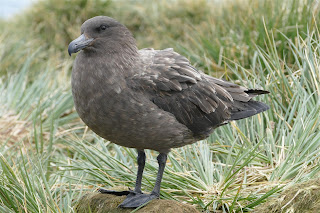Now that first call has been finished on the second attempt I have been able to settle more
into my role as the Penguin and Giant Petrel Zoological Field Assistant on Bird
Island; and it is time to introduce the team and main study species.
I am learning the role from Al Wilson, who has been on island for over a year, and Jerry Gillham, who took on the role for 2.5 years between late 2012 and early 2015 and who has now returned as our station leader for the summer.
I am learning the role from Al Wilson, who has been on island for over a year, and Jerry Gillham, who took on the role for 2.5 years between late 2012 and early 2015 and who has now returned as our station leader for the summer.
Lucy Quinn is the Albatross Zoological Field Assistant who
has extended her time on island to stay for a second winter. James Robbins is
currently learning from Siân Tarrant as the Seal Zoological Field Assistants
and Ian Storey is our technical expert for the coming 12 months, taking on the role from Robbie Scott, keeping the
base running with power, heating and water.
(Team photos will come in the next blog, saving the first people shots for a special annual event!)
(Team photos will come in the next blog, saving the first people shots for a special annual event!)
Our ecological work falls in to two categories; LTMS and
non-LTMS. LTMS means long-term monitoring surveys; these have been conducted
for multiple years running, some for over 50 years depending on the work, in
order to understand the ecological trends of our study species. The non-LTMS
work is not long term and often consists of certain survey methods being used
for just a season or two in order to answer a specific question we have on the
target species.
But the types of work we do will be described as I do them
throughout my time on island. For now here is a quick introduction to each of
the species we will be working with:
Macaroni Penguin (Eudyptes
chrysolophus): Most commonly referred to as “Macs” these charismatic little
penguins are the subject of study in two main areas, Little Mac and Big Mac.
 |
| Macs |
Northern Giant Petrel (Macronectes
halli) and Southern Giant Petrel (Macronectes
giganteus): Collectively known as “Geeps” these two closely related species
are most distinguishable from each other by the coloured sheath on the tips of
their bills. Think traffic lights, red is top, or north for the Northern Geeps
whilst green is bottom, or south for the Southern Geeps.
Whilst these four are my main target species there are a
number of others that have some LTMS work that falls within my job description
as well.
White-chinned Petrel (Procellaria
aequinoctialis): One of the larger petrel species on the island, although
obviously still much smaller than the Geeps, these petrels are the only burrow nesting species we regularly monitor. Called “White-chins”
because of the small white marking below their bill. (As White-chins are burrow nesting photos are harder to come by, but I will provide some when going in to more detail on this species later in the season).
Imperial Shag (Phalacrocorax
atriceps): As this is the only member of the cormorant family on island
they are referred to as just “Shags”. Preferring to nest on cliff ledges they
are some of the more inaccessible colonies we monitor.
Brown Skua (Stercorarius
antarcticus): The local scavengers and predators (although the Geeps also
fit this description!) the “Skuas” are one of the more recent additions to our
study programme.
 |
| Skua |
South Georgia Pintail (Anas
georgica) and Snowy Sheathbill (Chionis
albus): The “Pintail” and “Poop-Chicken” (to put it nicely!) are the
subject of some small monitoring practises during the winter. The latter gets
its unusual nickname from its tendency to peck around in the faeces of other
animals for food, occasionally it will even peck in open wounds of seals!
 |
| Left: Poop-chicken - Right: Pintail |
Wandering Albatross (Diomedea
exulans): The “Wanals” or “Wanderers” are the largest flying bird in the
world and it takes them 18 months to raise a single chick. This means that even
when the quieter moments in winter arrive there will still be some Wanal chicks
to go and check on.
Black-browed Albatross (Thalassarche
melanophrys) and Grey-headed Albatross (Thalassarche
chrysostoma): Collectively called “Mollymawks”, the “Black-brows” and
“Grey-heads” are two closely related species spread across the island in
multiple colonies of various sizes.
Light-mantled Sooty Albatross (Phoebetria palpebrata): Termed “Sooties” these albatross are more
nervous than the other species and as such have less work attributed to them;
but some monitoring can be done.
 |
| Sooties |
Antarctic Fur Seal (Arctocephalus
gazella): Called “Furries” these are the most common species of seal on
Bird Island, crowding out the bay in front of our accommodation during the
summer.
Southern Elephant Seal (Mirounga
leonina): “Ellies” are the largest of the seals on Bird Island and breed
earlier in the year than the Furries. They certainly are impressive to see up
close!
 |
| Ellie - big male between some Furries |
Ultimately we all get to work with all the species as
certain studies often require more than one or two pairs of hands, plus being
such a small team on an island with one bird or seal for every 1.5m2
means having to work very closely together to get everything done!
So these are the main species I will be telling you all
about during my time on Bird Island. Of course there are other species living
here as well, or passing by on migration, and I am sure they will make their
presence known from time-to-time and I will let you know when they do. But for
now, I’m off to meet a penguin, or ten-thousand!
 |
| Views from the hills either side of Home Sweet Home! |


























